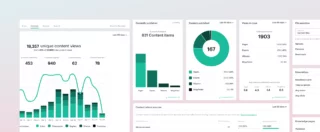Let’s be honest: the workplace isn’t what it used to be.
That’s not necessarily a bad thing. After all, computers do make a lot of things easier. And not all old tech is gone — many people still use pagers to this day. But the dictaphone? The dot matrix printer? The teletype? Gone, never to return. The march of modern technology has been swift and merciless.
With the explosion of (relatively) cheap computing power and available apps, technology is changing our workspaces faster than ever. And while some “upgrades” offer a lot of flash with little reward, discerning business leaders can use technology to empower their workforce, support their well-being, and greatly improve the employee experience.
(Remote) teamwork makes the dream work
The pandemic led to an unprecedented increase in remote work. According to a recent study, 41% of the people who work remotely want to stay remote. While many are open to hybrid working, the undeniable truth is that the work environment has changed, and remote workers want an end to what experts call “remote work inequity.”
Remote workers often feel they’re being left behind, too far outside the company culture to be considered for promotions even when they’re among its top performers. Because they aren’t in the office, they miss those small moments of interaction between employees as they pass by a desk or fridge. Fortunately, workers who engage with the business digitally don’t have to be marginalized. The right employee experience technology can transform remote and hybrid teams into close-knit units of agile, strategic innovation.
For a great digital experience, you’ll need the right technological infrastructure in place to optimize employee productivity. IT plays a critical role in the employee experience. From collaboration tools to workplace-focused social media, workplace technology is constantly expanding. Top talent craves flexibility, and a high-quality remote work option will not only improve hiring but retention as well.
See the results of our Employee Experience Tech Stack Survey.
Think about every aspect of the employee lifecycle
New technology isn’t just about helping employees do their jobs — it’s about improving every stage of the employee journey. From recruitment to retirement, a company culture that embraces technology can reduce burnout and enhance every touchpoint in the employee experience.
Harvard Business Review reports that 82% of surveyed workers agree: the performance of workplace technology has a significant impact on employee engagement and happiness. Processes like onboarding, communication, collaboration, and more can all be streamlined and improved through the use of smart analytics, data, and automation technology.
Learn more in our podcast Using Data to Improve Technology & the Human (Employee) Experience.
Digital tools to consider in improving the employee experience
As you think about user experience in the workplace, approach the problem through a structured framework. Start with a bird’s eye view and address each touchpoint in the employee lifecycle. Then, let individual teams and frontline workers request any additional technology they need to perform their specific job functions.
When adding each new app to your tech stack, make sure your intranet offers native integrations to keep your internal communications running smoothly.
1. Job application and recruitment workflows
Apps designed for HR leaders can streamline the long, complex process of recruitment. While collecting applicant data and facilitating recruitment workflows for HR teams, these same apps also provide a better user experience for potential new hires. This invites a stronger applicant pool and positions your company as a top contender.
2. Onboarding programs
An employee’s onboarding process isn’t just important to help a new hire navigate a new organization, but it also has a significant impact on a company’s bottom line. A great onboarding process can improve employee retention by 82% and increase productivity by over 70%. The often hectic process of onboarding can be eased significantly by talent-management programs like Workday that organize the flows for new hires as well as the transitions that come with internal promotions.
A modern intranet can connect into Workday and other popular integrations, keeping employee information updated in real-time and documents all in one place for a much more welcoming and streamlined process for new hires. Learn how Nutanix cut onboarding time in half by improving the efficiency when individuals searched for onboarding materials.
3. Training management and delivery systems
These HR lifesavers provide ongoing instruction and development opportunities to employees in an easy-to-use format with automatic documentation. While standalone programs assist with one aspect of engagement — mastery — they often aren’t designed to support the process of continuous improvement by measuring engagement or building community.
A modern intranet platform like Simpplr offers built-in analytics to support HR and Internal Comms professionals in these efforts. Which of your employees are most active and engaged with content? What are your most popular and least popular sites across your intranet? By uncovering insights about your people and content, you’ll be able to optimize your content to better engage employees.

4. Human resources management systems
The digital transformation of the workplace experience has been particularly impactful for HR, allowing for the automation of many of their more repetitive tasks. These programs centralize and simplify the many tasks of your HR department while offering self-service options for employees to manage their perks, log vacation time, and more.
5. Communication and collaboration systems
Apps like Slack or Microsoft Teams help employees communicate and collaborate in real-time no matter where they’re located. Forbes notes that communication is key to employee satisfaction, which in turn increases employee retention and productivity.
6. Real-time employee engagement surveys
Employees leave companies for a variety of reasons, but a major reason is that they feel disconnected and lacking a sense of belonging to their organization. If your employees feel heard and that their opinions matter, it’ll make for a better employee experience and help you retain talent.
Gathering employee feedback is crucial to improving the employee experience. Quality employee surveys with well-thought-out questions and great analytics not only make for a great employee experience but often lead to a high-quality customer experience too as employees become happier and more engaged.
However, if you conduct surveys only on an annual or quarterly basis, by the time you get to review the insights, the issues that employees bring up may have been brewing for a long time and it might be a bit too late to make changes. Instead, with a modern intranet like Simpplr it’s possible to conduct pulse surveys on required pieces of content and get real-time sentiment checks on new initiatives. For example, if you’re planning a regional return to the office, you might want to ensure that employees are feeling positive about the change. And if they have any issues with a change, you need to know soon, so you can adjust the message, bring it up with leadership and pivot before you have a toxic situation on your hands.
Modern intranet software ties it all together
One of the greatest improvements of the information age is the ability to automate workflows and improve work efficiency. To make the most of those systems, employee experience technology like Simpplr’s Live EX™️ experience management platform streamlines the process of digital and cultural transformation.
Built-in analytics and in-the-moment feedback let you keep your finger on the pulse of your organization, knowing what’s working and what isn’t, in real-time. If you’re ready to upgrade your employee experience and learn the benefits of a modern intranet software, get a live demo to explore how Simpplr can help you build a better workplace.
















